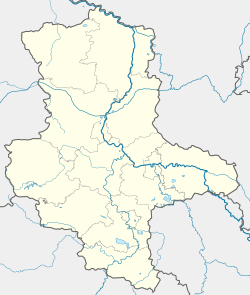world.wikisort.org - Germany
Wettin is a small town belonging to the municipality of Wettin-Löbejün in the Saale District of Saxony-Anhalt (Saxony-Ascania), Germany. It is situated on the River Saale, just north of Halle. It is known for Wettin Castle (German: Burg or Schloss Wettin), the ancestral seat of the House of Wettin, the former ruling dynasty of Saxony, Poland, the United Kingdom, Belgium, and Bulgaria. The town and its name are of Slavic origin.
Wettin | |
|---|---|
Ortsteil of Wettin-Löbejün | |
 Wettin Castle on the Saale river | |
 Coat of arms | |
Location of Wettin  | |
 Wettin  Wettin | |
| Coordinates: 51°35′N 11°48′E | |
| Country | Germany |
| State | Saxony-Anhalt |
| District | Saalekreis |
| Town | Wettin-Löbejün |
| Area | |
| • Total | 27.19 km2 (10.50 sq mi) |
| Elevation | 73 m (240 ft) |
| Population (2009-12-31) | |
| • Total | 2,355 |
| • Density | 87/km2 (220/sq mi) |
| Time zone | UTC+01:00 (CET) |
| • Summer (DST) | UTC+02:00 (CEST) |
| Postal codes | 06193 |
| Dialling codes | 034607 |
| Vehicle registration | SK |
| Website | www.wettin.de |
Geography
Wettin lies in the Saalekreis (Saale District) of the eastern German federal state of Saxony-Anhalt, on the river Saale, which flows into the Elbe further north. Wettin belongs to the municipality of Wettin-Löbejün which borders Saxony-Anhalt's most populous city of Halle-on-the-Saale in the southeast. It further borders Petersberg and Salzatal in the Saale District, Gerbstedt in the district of Mansfeld-Südharz (Mansfield-Southern Harz), Könnern in the Salzlandkreis (Saltland District), and Südliches Anhalt in the district of Anhalt-Bitterfeld (Ascania-Bitterfield). The Saale District (German: Saalekreis), which Wettin-Löbejün is a part of, surrounds the city of Halle. The nearest international airport is Leipzig/Halle Airport in Schkeuditz, southeast of Halle. The municipality of Wettin-Löbejün further consists of the villages of Brachwitz, Döblitz, Domnitz, Gimritz, Löbejün, Nauendorf, Neutz-Lettewitz, Plötz, and Rothenburg. Most of these villages are of Slavic origin.
History
Historical Affiliations
Archbishopric of Magdeburg 1288-1680
Duchy of Magdeburg 1680-1807
Kingdom of Prussia 1701-1918
Province of Saxony 1815-1944
North German Confederation 1866-1871
German Empire 1871-1918
Free State of Prussia 1918-1933
Weimar Republic 1919-1933
Nazi Germany 1933-1945
Halle-Merseburg 1944-1945
Allied-occupied Germany 1945-1949
Saxony-Anhalt 1946-1952
East Germany 1949-1990
Saxony-Anhalt 1990-
Germany 1990-
Wettin was first documented as Vitin civitas in a 961 deed issued by German king Otto I. The settlement thereafter was a burgward within the Saxon Eastern March, held by Dietrich I von Wettin, the progenitor of the dynasty. His descendants became Margraves of Lusatia in 1032 and of Meissen in 1123. In 1288 Wettin was acquired by the Magdeburg archbishop Eric of Brandenburg.
- Mücheln
- The small village of Mücheln (not to be confused with the larger Mücheln near Merseburg) became[when?] part of Wettin and includes the restored old chapel of the Poor Fellow-Soldiers of Christ and of the Temple of Solomon (Knights Templar).
- Lützkendorf
- As bombing targets of the Oil Campaign of World War II, the Lützkendorf oil facilities 2 miles East of Mücheln included
- The Lützkendorf Grube supplied lignite from the south end of the mine to the two interconnected plants ("Lutzkendorf" and "Lutzkendorf-Mücheln")[3] at 51°17′N 11°52′E, and the facility also used tar for Low Temperature Carbonization.[2]

References
- "The How and Why Air Attacks Crippled the German Oil-Chemical Industry: Natural Oil Targets". Orbat.com. Archived from the original on 2011-06-14. Retrieved 2009-10-24.
-
Stranges, Dr. Anthony. "Fischer-Tropsch Archive". Washington, D.C.: Fischer-Tropsch.org. Retrieved 2009-10-23.
- U.S. Government Technical Oil Mission. "Summaries: Microfilm 2" (PDF). pp. 2, 5, 11, 14, 15. Archived from the original (PDF) on 2011-07-16. Retrieved 2009-10-23.
- Western Axis Subcommittee. "ITEM 11D: Synthetic Oil Plants in Germany" (PDF). Enemy Oil Committee. pp. 160, 191. Retrieved 2009-10-23.
- HQ. U.S.S.T.A.F. (5 March 1944), Plan for Completion of Combined Bomber Offensive, Dwight D. Eisenhower Presidential Library: SMITH, WALTER BEDELL: Collection of World War II Documents, 1941-1945; Box No.: 48: HQ, U.S.S.T.A.F,
Copy 1 … MOST SECRET … DECLASSIFIED … 4/4/74
{{citation}}: CS1 maint: location (link)
На других языках
[de] Wettin
Wettin ist ein Ortsteil der Stadt Wettin-Löbejün im Saalekreis in Sachsen-Anhalt. Bekannt ist die Kleinstadt vor allem durch das Herrschergeschlecht der Wettiner, das Markgrafen, Kurfürsten und Könige in Sachsen, Großbritannien, Belgien, Bulgarien sowie in Polen stellte.- [en] Wettin, Saxony-Anhalt
[es] Wettin
Wettin, actualmente, es un barrio de la ciudad de Wettin-Löbejün en Saalekreis en Sajonia-Anhalt, Alemania. Es conocida la ciudad, especialmente a través de la dinastía de la Casa de Wettin, con marqueses, príncipes-electores y monarcas en Sajonia, Gran Bretaña, Bélgica, Bulgaria y Polonia.[2][fr] Wettin
Wettin /vɛˈtiːn/ est une localité allemande de Saxe-Anhalt, dans l'arrondissement de Saale. Elle se dresse sur un coteau escarpé en rive droite de la Saale, à environ 20 km au nord de Halle (Saale), au cœur du parc naturel de la Saale inférieure. Ce bourg est traversé par les fossés de la reine Louise. Il compte environ 2 400 habitants (2009).[it] Wettin (Wettin-Löbejün)
Wettin è una frazione della città tedesca di Wettin-Löbejün,[1] celebre per aver dato nome all'omonima dinastia.[ru] Веттин (город)
Веттин (нем. Wettin) — район города Веттин-Лёбеюн в немецкой федеральной земле Саксония-Анхальт.Другой контент может иметь иную лицензию. Перед использованием материалов сайта WikiSort.org внимательно изучите правила лицензирования конкретных элементов наполнения сайта.
WikiSort.org - проект по пересортировке и дополнению контента Википедии